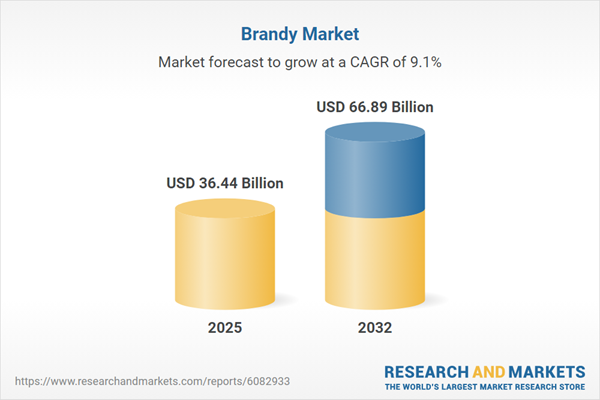Speak directly to the analyst to clarify any post sales queries you may have.
The global brandy market is experiencing substantial evolution, driven by transitions in consumer behavior, regulatory requirements, and the integration of new technologies. Senior decision-makers are reassessing established strategies to align with a shifting commercial and regulatory environment, where informed, agile responses to market complexity foster business resilience and growth.
Market Snapshot: Brandy Market Size and Growth Outlook
The brandy market shows consistent expansion, with a market value increasing from USD 33.40 billion in 2024 to USD 36.44 billion in 2025, and projected to reach USD 66.89 billion by 2032. This represents a compound annual growth rate (CAGR) of 9.06%, reflecting sustained global demand. The market's progress is anchored by premiumization and broader consumption occasions, presenting robust opportunities for senior leaders to reinforce competitiveness by aligning product and distribution strategies with emerging buyer expectations and international market trends.
Scope & Segmentation
Senior stakeholders and strategic planners benefit from comprehensive segmentation within the global brandy market, supporting data-driven risk management and market-entry decisions through the following dimensions:
- Product Types: Covers American Brandy, Cognac, and Fruit Brandy, capturing both tradition and evolving innovation in brandy offerings across diverse consumer bases.
- Age Groups: Spans Up To 2 Years, 2 To 5 Years, and Over 5 Years, reflecting buyer preferences for either youthful expressiveness or matured depth in flavor profile.
- Packaging Formats: Includes Bag In Box, multiple glass bottle sizes (750 ml, 1 L, 1.75 L), and Tetra Pak packages, enabling tailored solutions for retail and on-premise requirements.
- Distribution Channels: Encompasses Off-Trade options—Liquor Stores, Online Retail (Direct To Consumer), Online Marketplaces, Supermarkets and Hypermarkets—as well as On-Trade venues such as Bars & Clubs and Restaurants & Hotels, facilitating omnichannel market access strategies.
- Regions: Incorporates Americas (United States, Canada, Mexico, Brazil, Argentina, Chile, Colombia, Peru), Europe, Middle East & Africa (from United Kingdom and Germany to Turkey and Kenya), and Asia-Pacific (China, India, Japan, Australia, and others), addressing varied demand patterns and regulatory frameworks worldwide.
- Technology and Initiatives: Features advances including precision distillation, maturation analytics supported by real-time data, blockchain-based traceability for supply chain transparency, sustainable energy incorporation, and adoption of eco-friendly packaging to reinforce innovation, traceability, and environmental performance.
- Profiled Companies: Highlights key participants such as Moët Hennessy SAS, Pernod Ricard SA, Rémy Cointreau SA, Camus SAS, E. & J. Gallo Winery, Osborne SA, S.P. Ararat Brandy Factory, Georgian Wines & Spirits Company, La Martiniquaise-Bardinet, and Bacardi Limited, providing essential market benchmarks for ongoing strategy refinement.
Key Takeaways: Strategic Insights for Decision-Makers
- Premiumization continues to redefine brand portfolios, encouraging the development of both longstanding and specialty products to enhance brand equity.
- Investment in production technology and digitalized supply chain solutions increases operational efficiency and supports improved end-to-end supply visibility.
- Sustainability in sourcing and packaging is increasingly fundamental in procurement and manufacturing, aligning with evolving environmental policies and customer preferences.
- Diverse regional regulatory frameworks, particularly in Asia-Pacific and throughout the Americas and EMEA, underscore the necessity of localized approaches and customized market access tactics.
- The rise of multiple retail formats, especially digital, is amplifying market reach, deepening consumer engagement, and generating new loyalty pathways within global and regional segments.
Tariff Impact: Navigating Regulatory Shifts
Recent tariff changes affecting European brandy imports into the United States have led to higher import duties, prompting a reevaluation of sourcing strategies. Domestic producers are leveraging patriotic themes and premium narratives to reinforce competitive positioning, while importers adapt by reconsidering pricing, supplier relationships, and logistics. The focus has shifted toward strengthening local production and optimizing distribution routes to secure resilient supply amid new market regulations.
Methodology & Data Sources
Insights in this report are drawn from targeted primary interviews with industry experts, on-site reviews of brandy production operations, and structured analysis of regulatory filings and international trade records. The research process is substantiated by expert validation panels and rigorous statistical review, supporting accuracy and transparency across all quantitative findings.
Why This Report Matters
- Presents actionable segmentation and in-depth intelligence for executive teams, enhancing capital allocation and global or region-specific go-to-market planning.
- Provides clarity on regulatory and tariff developments, empowering organizations to proactively mitigate risks and capture new business opportunities.
- Supports decision-makers with detail on technology adoption and sustainable practice integration, aligning product development and supply choices with modern market standards.
Conclusion
Ongoing innovation and adaptation to evolving regulatory and consumer expectations are crucial for advancing leadership in the brandy sector. Organizations that implement precise segmentation, prioritize sustainability, and expand distribution capabilities will reinforce their market position.
Table of Contents
3. Executive Summary
4. Market Overview
7. Cumulative Impact of Artificial Intelligence 2025
Companies Mentioned
The companies profiled in this Brandy market report include:- Moët Hennessy SAS
- Pernod Ricard SA
- Rémy Cointreau SA
- Camus SAS
- E. & J. Gallo Winery
- Osborne SA
- S.P. Ararat Brandy Factory
- Georgian Wines & Spirits Company
- La Martiniquaise-Bardinet
- Bacardi Limited
Table Information
| Report Attribute | Details |
|---|---|
| No. of Pages | 187 |
| Published | October 2025 |
| Forecast Period | 2025 - 2032 |
| Estimated Market Value ( USD | $ 36.44 Billion |
| Forecasted Market Value ( USD | $ 66.89 Billion |
| Compound Annual Growth Rate | 9.0% |
| Regions Covered | Global |
| No. of Companies Mentioned | 11 |









